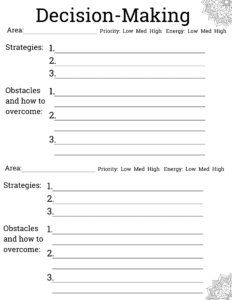Making Decisions…
Every day, we make many decisions. There are two main types of decisions-making we engage in: closed-end decisions and open-ended decisions. Closed-end decisions involve clear-cut options. Some example scenarios may include, Do I accept this job offer? Should I buy this sweater in grey or blue? or Do I make my appointment at the 11AM, 11:30AM, or 2PM availability? Open-ended decisions, however, involve room for options. Examples of this kind of decision-making include, what should I eat today, what do I want to do this weekend, and how can I improve this area of my life?
Open-ended decision making is what we will be focusing on today. Open-ended decision making can feel very overwhelming because there aren’t always clear-cut options or answers like in close-ended. However, I am here to tell you that open-ended decision making doesn’t have to be daunting! Below, you will find a step-by-step process to help reduce the overwhelm of options. With this article I have also included a free worksheet outlining the steps for decision-making that you will see next. Feel free to print it out and use it as you follow along.
Practicing Open-Ended Decision Making
Choose an Area of Life
First, you are going to want to pick an area of your life you either need to make decisions in, or want to make some changes/pursue a goal. Examples of these areas include school, work, self-care, physical health, parenting, relationships (familial, platonic, or romantic), spirituality, or recreation. Of course, these are examples, and if there are other areas of life that are not mentioned that apply to you, feel free to use it. If you are following along with the worksheet, write this area of life in the “area” section.
Assess Priority and Energy Level
Next you are going to assess where this area of life currently stands in your day-to-day. First, you are going to decide how much priority this area takes in your life on a scale of low, medium, or high. Keep in mind, there is no right or wrong answer. For example, perhaps there is pressure to say work is a high priority, but in accordance to your values it takes on a medium priority. That’s okay! Be honest with yourself, and meet yourself with where you are at this time. Then, using the same scale of low, medium, or high, decide how much energy this area of life is currently using. For example, sticking with the work example, if you find you are working long shifts and feel exhausted after work, you would rate it as “high energy.” You can circle your answers on the worksheet. This portion of the exercise is based off of a Dialectical Behavioral Therapy (DBT) strategy of ranking the importance and effort put into various areas of life.1
Brainstorm and Break it Down
Brainstorming is a powerful tool when it comes to decision-making. By coming up with more than one potential solution, you create a toolkit of strategies to try out in case your first strategy doesn’t work (and if it does it helps set further goals). Try brainstorming three potential strategies for the area of life you chose based on what priority you deemed this area and how much energy it currently takes to engage in this area. Sticking with the work example, let’s say you ranked work as medium priority but high in energy. To make this area more balanced, you may come up with the following strategies: stop checking my work e-mail after hours, see if there is an assignment that can be delegated, and engage in 10 minutes of self-care after work. If you are using the worksheet, there are three spaces for three different goals/strategies to try.
Acknowledge Potential Obstacles
Sometimes, obstacles can get in the way of our strategies and goals. It can be helpful to try and identify them ahead of time so you can come up with possible ways to handle the obstacle. If you are using the worksheet you will see three spaces, with two lines each. On the first line, you will write a potential obstacle. On the second line, you will write how you plan on handling this obstacle. Let’s go back to the work example. As I mentioned previously, the three strategies that were brainstormed are stop checking work e-mail after hours, see if there is an assignment that can be delegated, and engage in 10 minutes of self-care after work.
If I were brainstorming potential obstacles and how to get around them I may come up with the following:
Obstacle #1: The desire to check my work email. To help, I will get around it by turning off my work notifications on my phone after work.
Obstacle #2: I may be too nervous to ask someone else for assistance. To help, I will type up an email template ahead of time so I simply need to copy, paste, edit, and send when I do need assistance.
Obstacle #3: I may be too tired from work for self care. To help, I will find less exertive acts of self care, such as listening to music. Now it is your turn, what obstacles and ways to get around them can you think of?
Putting it all together
Putting it all together there should be four main components to this strategy:
- Choosing an area of life
- Assessing the priority and energy level
- Brainstorming and breaking it down
- Acknowledge and plan for potential obstacles
Using the work example, the four parts would consist of:
- Area: Work
- Priority: Medium / Energy: High
- Strategies to try: Stop checking work e-mail after hours, See if there is an assignment that can be delegated, Engage in 10 minutes of self-care after work
- Obstacles and ways to get around them:
- the desire to check my work email
I will get around it by turning off my work notifications on my phone after work.
- I may be too nervous to ask someone else for assistance
I will type up an email template ahead of time so I simply need to copy, paste, edit, and send.
- I may be too tired from work for self care
I will find less exertive acts of self care, such as listening to music.
Practical Applications
Feel free to use the free worksheet I have included, which you can use again and again for different area of your life!

CLICK IMAGE TO DOWNLOAD
Curious about more that you can be doing to achieve your goals this year? Here at online-therapy.com we have a team of wonderful therapists here to assist you. To learn more about our program and therapy options please visit us at https://www.online-therapy.com/create_account.php
Enjoy the strategy, and get decision-making!
Reference:
Linehan, M. (2015). Dbt skills training handouts and worksheets. The Guilford Press.




Leave A Comment